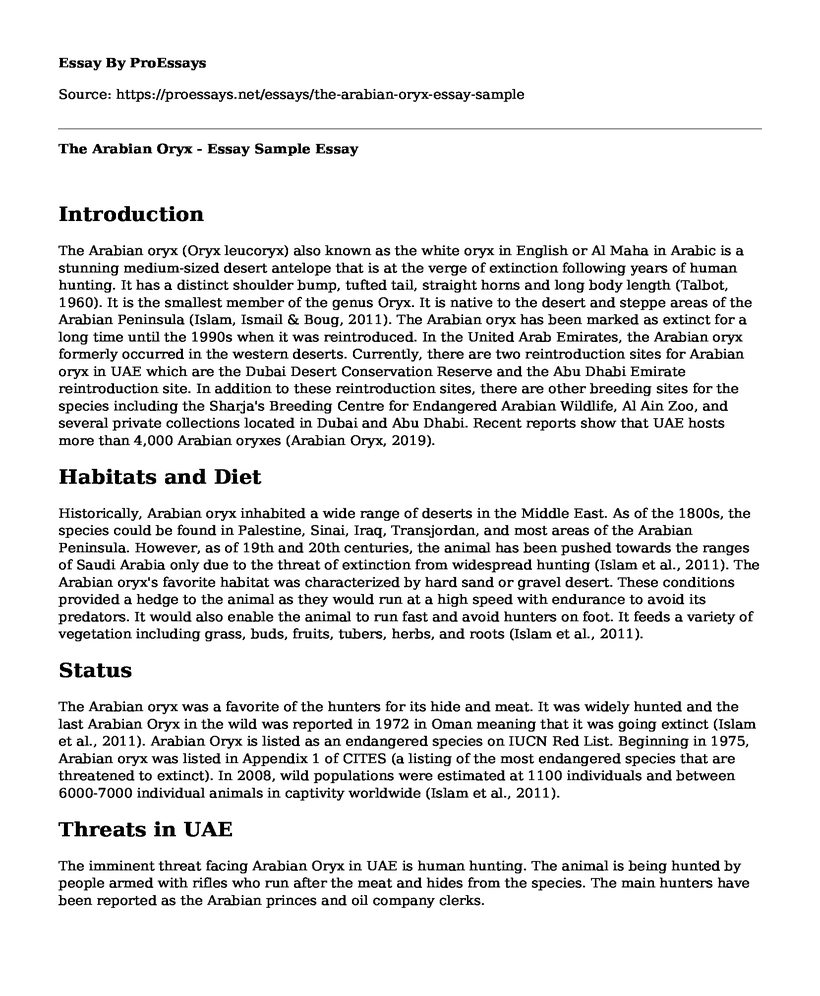Introduction
The Arabian oryx (Oryx leucoryx) also known as the white oryx in English or Al Maha in Arabic is a stunning medium-sized desert antelope that is at the verge of extinction following years of human hunting. It has a distinct shoulder bump, tufted tail, straight horns and long body length (Talbot, 1960). It is the smallest member of the genus Oryx. It is native to the desert and steppe areas of the Arabian Peninsula (Islam, Ismail & Boug, 2011). The Arabian oryx has been marked as extinct for a long time until the 1990s when it was reintroduced. In the United Arab Emirates, the Arabian oryx formerly occurred in the western deserts. Currently, there are two reintroduction sites for Arabian oryx in UAE which are the Dubai Desert Conservation Reserve and the Abu Dhabi Emirate reintroduction site. In addition to these reintroduction sites, there are other breeding sites for the species including the Sharja's Breeding Centre for Endangered Arabian Wildlife, Al Ain Zoo, and several private collections located in Dubai and Abu Dhabi. Recent reports show that UAE hosts more than 4,000 Arabian oryxes (Arabian Oryx, 2019).
Habitats and Diet
Historically, Arabian oryx inhabited a wide range of deserts in the Middle East. As of the 1800s, the species could be found in Palestine, Sinai, Iraq, Transjordan, and most areas of the Arabian Peninsula. However, as of 19th and 20th centuries, the animal has been pushed towards the ranges of Saudi Arabia only due to the threat of extinction from widespread hunting (Islam et al., 2011). The Arabian oryx's favorite habitat was characterized by hard sand or gravel desert. These conditions provided a hedge to the animal as they would run at a high speed with endurance to avoid its predators. It would also enable the animal to run fast and avoid hunters on foot. It feeds a variety of vegetation including grass, buds, fruits, tubers, herbs, and roots (Islam et al., 2011).
Status
The Arabian oryx was a favorite of the hunters for its hide and meat. It was widely hunted and the last Arabian Oryx in the wild was reported in 1972 in Oman meaning that it was going extinct (Islam et al., 2011). Arabian Oryx is listed as an endangered species on IUCN Red List. Beginning in 1975, Arabian oryx was listed in Appendix 1 of CITES (a listing of the most endangered species that are threatened to extinct). In 2008, wild populations were estimated at 1100 individuals and between 6000-7000 individual animals in captivity worldwide (Islam et al., 2011).
Threats in UAE
The imminent threat facing Arabian Oryx in UAE is human hunting. The animal is being hunted by people armed with rifles who run after the meat and hides from the species. The main hunters have been reported as the Arabian princes and oil company clerks.
Ways to Protect
Given the imminent threat of hunting for the Arabian oryx, the only way to protect this animal is keeping them in reintroduction sites that have already been established in UAE. However, these reintroduction sites should be located in the Arabian Peninsula region to ensure that the animal is kept within its favorite habitats characterized by dry and hot environments. The reintroduction sites should establish breeding centers to ensure that new offspring are bred and raised up to sustain the population growth. Also, strict anti-poaching laws should be established to discourage hunters.
References
Arabian Oryx (2019). Home. [online] Arabianoryx.org. Available at: https://www.arabianoryx.org/En/UAE/Pages/default.aspx [Accessed 2 Feb. 2019].
Islam, M. Z. U., Ismail, K., & Boug, A. (2011). Restoration of the endangered Arabian Oryx Oryx leucoryx, Pallas 1766 in Saudi Arabia lessons learned from the twenty years of re-introduction in arid fenced and unfenced protected areas: (Mammalia: Artiodactyla). Zoology in the Middle East, 54(sup3), 125-140.
Talbot, L. M. (1960). A Look at threatened species. The Fauna Preservation Society. pp. 84-91
Cite this page
The Arabian Oryx - Essay Sample. (2022, Nov 14). Retrieved from https://proessays.net/essays/the-arabian-oryx-essay-sample
If you are the original author of this essay and no longer wish to have it published on the ProEssays website, please click below to request its removal:
- Technology Essay Example: Solar Panels
- Climate and Disaster Resilience Essay
- Characteristics of the Smart Cities Towards Sustainable Disclosure Essay
- An Analysis of the Effects of Global Warming on Climatic Changes
- Essay on Coping with Climate Change and Global Warming
- Air Quality and Pollutants Essay
- Essay Sample on Katrina's Wrath: Unprecedented Destruction and Loss of Life







